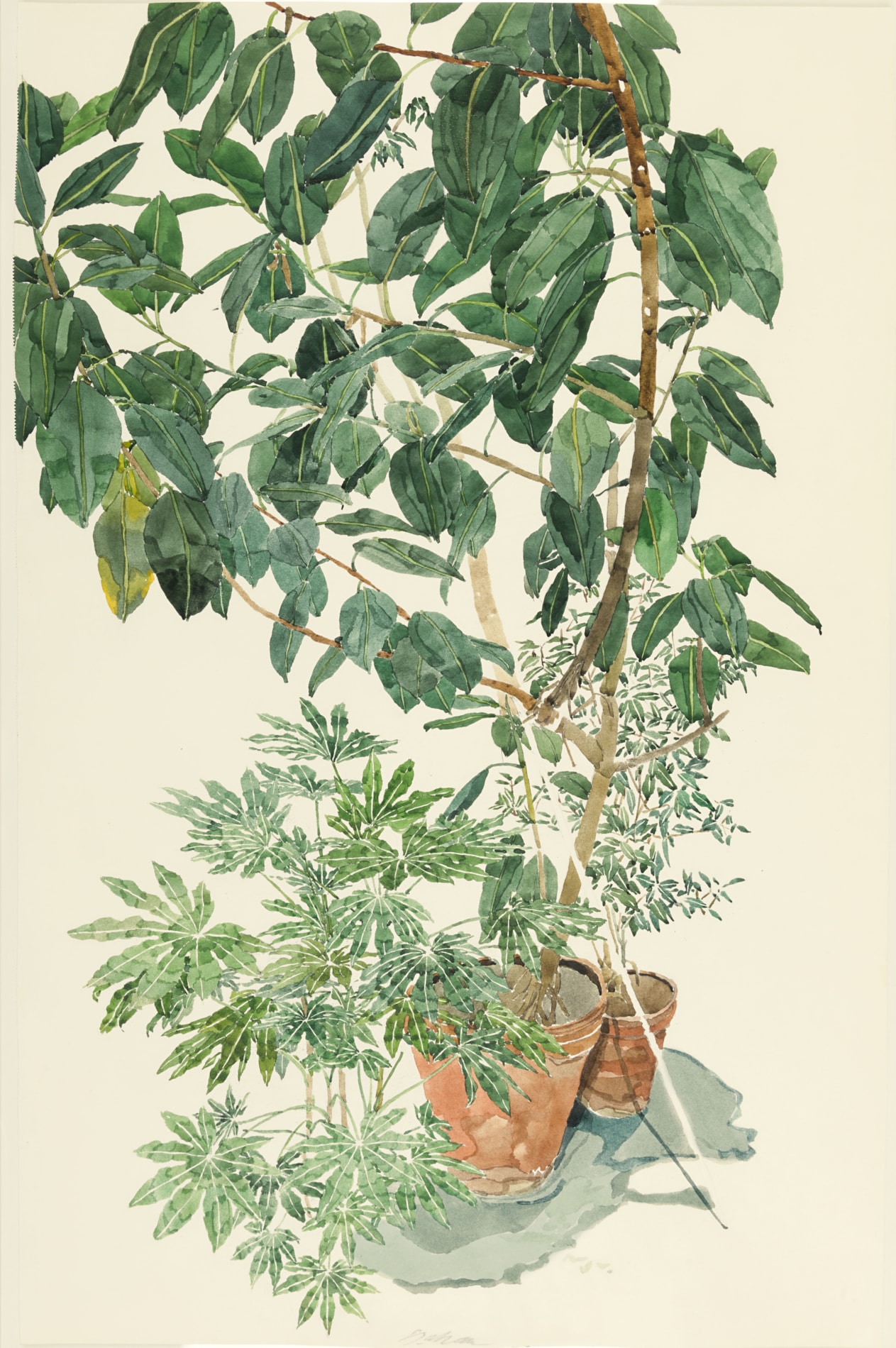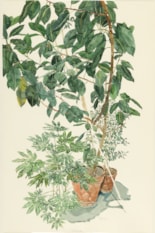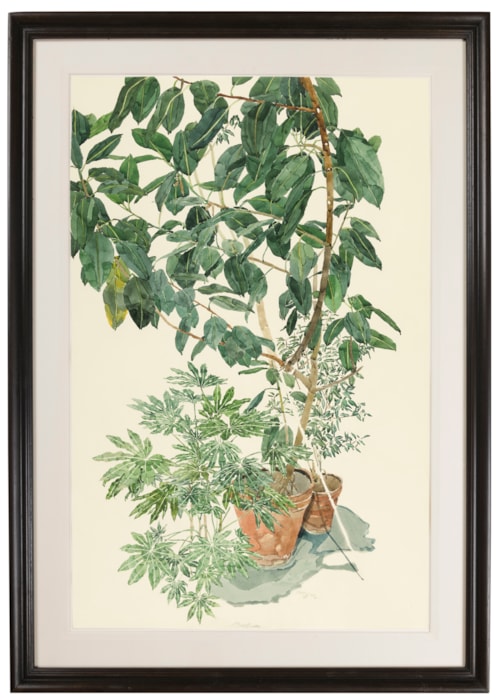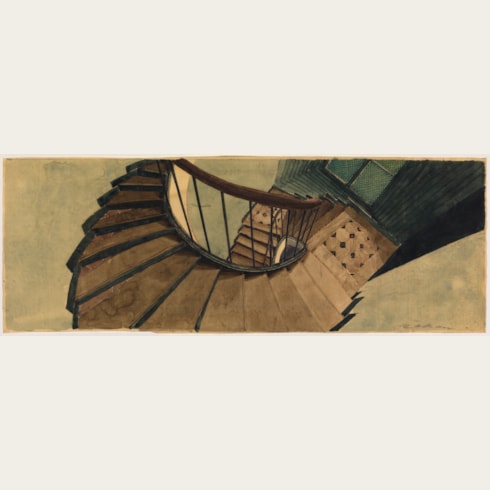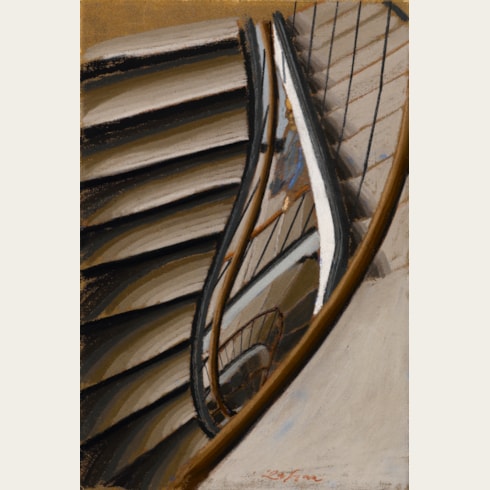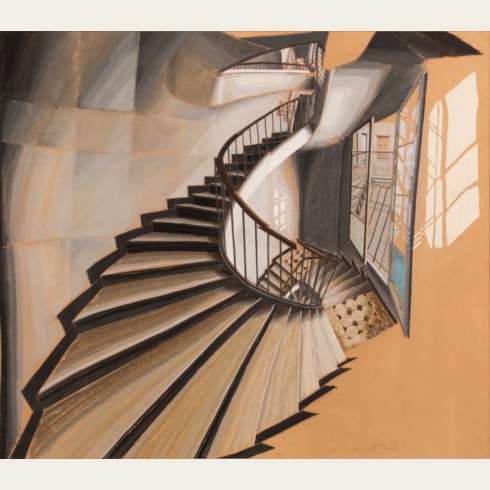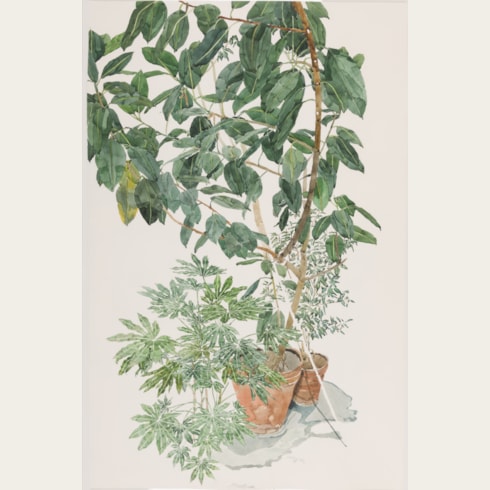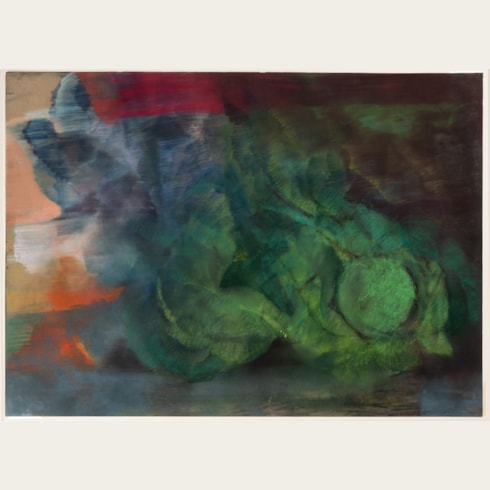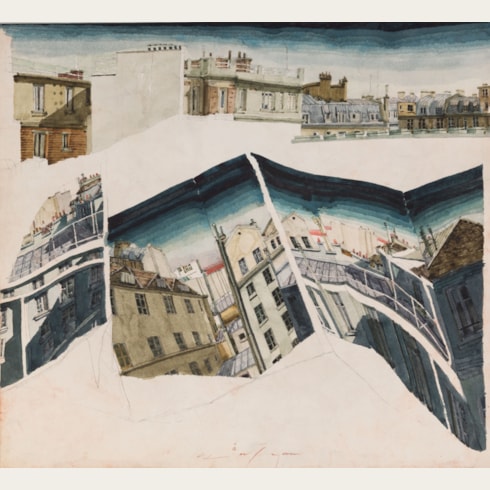Sam SZAFRAN
(Paris 1934 - Paris 2019)
Untitled (Plants)
Sold
Watercolour on paper; a page from a large sketchbook.
Signed Szafran in pencil at the lower centre.
737 x 476 mm. (29 x 18 3/4 in.)
Signed Szafran in pencil at the lower centre.
737 x 476 mm. (29 x 18 3/4 in.)
Throughout his career, Sam Szafran concentrated on a small range of subjects, notably views of the interior of his studio and of a staircase in an apartment building on the rue de Seine in Paris. Drawn in 1986 or 1987, this very large watercolour depicts another of the artist’s favourite subjects; the plants which filled his Parisian studio. For over fifty years, Szafran produced what he called ‘feuillages’, or studies of potted plants in interior spaces. As the artist’s friend James Lord has written of these ‘feuillages’ by Szafran, ‘Then there is a leap into the universe of vegetation. Plants. Infinite interstices of leaves in their imperceptible palpitation, profusion, perfection, each leaf limned upon the vibrant air with horticultural precision. Aerial tendrils dangling down through the multitudinous greenery, seeking sustenance even as they provide its structure. Stalks and stems sprouting and supporting: the armature of this dense but fragile vegetal architecture…the glimpse we occasionally catch of a human presence amidst the luxuriant, polymorphous foliage is fragmentary, fleeting. Verdure endures alone and exuberant in the fructification of itself.’
As the artist himself has noted of such works as this, ‘My obsession with plants has found here…its best grounds to express itself. These large watercolours are the negative of the positive of the blue leaf pastels of the 1970s. They are the result of chain reactions that provoke continuous deviations.’
James Lord adds that ‘Szafran’s staircases and plants are the output of an eye dedicated to the absolutism of its own experience, disciplined by self-effacement before what sight alone can convey to the senses but submissive at the same time to the sublimating want of self-expression. Proceed with caution upon these stairs and amongst the vegetation. Aesthetic delight is dangerous. The pleasure of familiar forms is deceptive…Seeing Szafran shows how wonderfully well looking can think.’
Throughout much of Sam Szafran’s career, his work was acquired by a coterie of enthusiastic and devoted collectors. Prominent among these was the French-American businessman and passionate collector William Louis-Dreyfus (1932-2016), who assembled an exceptional group of works by the artist that spanned several decades of his career.
As the artist himself has noted of such works as this, ‘My obsession with plants has found here…its best grounds to express itself. These large watercolours are the negative of the positive of the blue leaf pastels of the 1970s. They are the result of chain reactions that provoke continuous deviations.’
James Lord adds that ‘Szafran’s staircases and plants are the output of an eye dedicated to the absolutism of its own experience, disciplined by self-effacement before what sight alone can convey to the senses but submissive at the same time to the sublimating want of self-expression. Proceed with caution upon these stairs and amongst the vegetation. Aesthetic delight is dangerous. The pleasure of familiar forms is deceptive…Seeing Szafran shows how wonderfully well looking can think.’
Throughout much of Sam Szafran’s career, his work was acquired by a coterie of enthusiastic and devoted collectors. Prominent among these was the French-American businessman and passionate collector William Louis-Dreyfus (1932-2016), who assembled an exceptional group of works by the artist that spanned several decades of his career.
Born Samuel Berger in 1934 to Polish Jewish immigrants and raised in the area of Les Halles in Paris, Sam Szafran was imprisoned as a child at the Drancy internment camp, northeast of the city, during the Occupation. Following the Liberation he lived for some years with his mother and sister in Australia before returning to Paris in 1951, at the age of seventeen. He attended evening drawing classes and became friendly with a number of artists, including Jean Arp, Henri Cartier-Bresson, Yves Klein, Joan Miro and Jean-Paul Riopelle, as well as Alberto Giacometti. Although he was briefly enrolled at the Académie de la Grande-Chaumière in Paris in the mid-1950s, Szafran was largely self-taught as an artist. He took the maiden name of his mother when he began to sign his works, and exhibited at the Salon des Indépendants in 1957 and the Salon des Réalités Nouvelles two years later. While his earliest works were based in abstraction, from around 1960 onwards he began to depict representational subjects, drawn in pastel or charcoal and, from the late 1970s onwards, watercolour. Content with studying a limited range of themes - notably studio interiors, staircases and plant forms - he produced numerous drawings, each characterized by a very skillful handling of the medium and an abiding interest in perspectival effects. From 1965, when Szafran had his first solo exhibition, his work was exhibited extensively in France, and also in Switzerland, but only rarely elsewhere. Szafran contributed to the Nouvelle Subjectivité exhibitions curated by Jean Clair in Paris in 1976 and in Brussels in 1979. Throughout much of the artist’s career, his work was acquired by a coterie of enthusiastic and devoted collectors.
A retrospective exhibition of drawings, pastels, watercolours and sculptures by Szafran was held at the Fondation Pierre Gianadda in Martigny and the Fondation Maeght in Saint-Paul de Vence in 1999-2000. Later exhibitions followed at the Max Ernst Museum in Brühl in 2010-2011 and at the Fondation Gianadda in 2013. Following Szafran’s death in 2019, a large commemorative exhibition at the Musée de l’Orangerie in Paris in 2022-2023 drew some 330,000 visitors. In 2015 a permanent gallery devoted to Szafran’s work was established at the Fondation Gianadda in Martigny in Switzerland, while other works by the artist are today in the collections of the Metropolitan Museum of Art and the Museum of Modern Art in New York, the Centre National d’Art Contemporain, the Musée d’Orsay and the Musée d’Art Moderne in Paris, the Hirshhorn Museum and Sculpture Garden in Washington, D.C., the Musée Cantini in Marseille, and elsewhere.
A retrospective exhibition of drawings, pastels, watercolours and sculptures by Szafran was held at the Fondation Pierre Gianadda in Martigny and the Fondation Maeght in Saint-Paul de Vence in 1999-2000. Later exhibitions followed at the Max Ernst Museum in Brühl in 2010-2011 and at the Fondation Gianadda in 2013. Following Szafran’s death in 2019, a large commemorative exhibition at the Musée de l’Orangerie in Paris in 2022-2023 drew some 330,000 visitors. In 2015 a permanent gallery devoted to Szafran’s work was established at the Fondation Gianadda in Martigny in Switzerland, while other works by the artist are today in the collections of the Metropolitan Museum of Art and the Museum of Modern Art in New York, the Centre National d’Art Contemporain, the Musée d’Orsay and the Musée d’Art Moderne in Paris, the Hirshhorn Museum and Sculpture Garden in Washington, D.C., the Musée Cantini in Marseille, and elsewhere.
Provenance
The studio of the artist, Paris
Galerie Claude Bernard, Paris and New York
Purchased in 1987 by William Louis-Dreyfus, Mount Kisco
The William Louis-Dreyfus Foundation, from 2015.
Galerie Claude Bernard, Paris and New York
Purchased in 1987 by William Louis-Dreyfus, Mount Kisco
The William Louis-Dreyfus Foundation, from 2015.
Exhibition
New York, Claude Bernard Gallery, Sam Szafran: Recent Works, 1987, probably no.14.

